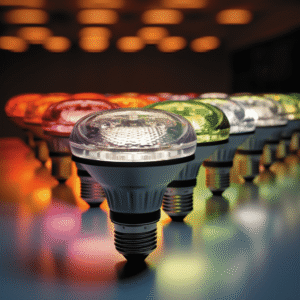R20 vs. PAR20 bulbs: In the lighting industry, there are so many letters and numbers that can get one confused. However, they refer to the light types and base types. Each number and letter denotes a different thing.
What difference is there between the R20 light and PAR20 bulb? Both of these bulbs share the same diameter and are reflector-type lights meaning they can apply in the same circumstances. The PAR20 is a better option for more focused light, while an R20 is great for dim/soft and general light.
To better understand how that is possible, we have a detailed breakdown of these two bulbs to enable you to make an informed choice.
Table of Contents
What is an R20 Bulb?
For a start, the number “20” refers to the bulb’s diameter, which, when divided by an eighth of an inch, equals 2.5 inches. The letter R refers to “Reflector,” meaning light is directed forward, creating a soft light than its counterpart, thus suitable for general lighting and not a crisp outer edge.
What is PAR20 Light?

It is a small bulb 2.5 inches in diameter, making sense of the number “20”. Historically, the bulbs are measured in eighths of an inch, so 20 eighths of an inch give the bulb width.
The PAR acronym means Parabolic Aluminized Reflector – a type of reflective coating on the inner part of the light that is used to direct the light. It is mostly used as a limelight or to highlight a specific spot where it is necessary.
R20 Bulb vs. PAR20 Bulb- Similarities
Size
Both lights have the same dimensions and similar common Edison Base. Both bulbs can allow the use of various light sources in the R20 and PAR20 types, including halogen and incandescent bulbs which give lights in all directions.
R20 vs. PAR20 – Differences
For several years the two types of bulbs have been the go-to choices of many due to their energy efficiency and durability. Nevertheless, when you want to upgrade your indoor or outdoor lighting, knowing the differences is crucial to distinguish between PAR and R for visual effects and meet your lighting expectation.
What do “R” and “PAR” Mean in LED Bulbs?
“R” means reflectors are light bulbs that contain an in-built reflecting surface to maximize the light directly emitted by the lamp. They are primarily used in recessed cans for retail, restaurants, hotels, and residential lighting.
“PAR ” means Parabolic Aluminized Reflector light bulbs are made with a parabolic-shaped aluminized reflector. They have hard glass that can withstand harsh conditions with wide coverage. More focused light enables it to be used as an accent light or a spotlight than a general room bulb.
Light
Three types of lighting methods are used for either R20 or PAR20 Bulbs: an incandescent bulb, whereby a filament inside the bulb heats up, making the light when the bulb is in use.
Second, is the halogen light an incandescent light with a difference? This bulb is smaller and filled with halogen gas enclosed inside the bigger bulb.
Lastly, the LED or diode light has a cool operation that lasts for a long time and uses less energy.
Output
R20 vs. PAR20 bulbs is for standard room lighting or soft lights for a particular area. An R20 light has no clear ends but a bright central area, making it fainter as it spreads out due to the frosted coating.
R20 vs. PAR20 bulbs are used in most homes as they serve as track lighting, pendants, or recessed can lighting. In addition, they are perfect to use in common areas such as living areas, kitchens, media rooms, hallways, or pool areas.
A PAR20 bulb is suitably used when a more focused beam is needed. It works well to lighten certain areas where diffuse lighting isn’t required. The aluminized coating directs to a particular focused area, yielding a stronger illumination area with defined limits.
R20 vs. PAR20 bulbs have two encases- one is made of the glass envelope, and the other is of shiny aluminum. As a result of the thick coating, they’re heavier, plus their texture is rough compared to R20, which is smooth and lighter.
Their thick enclosures are ideal for outdoor and indoor lighting, but majorly in track lights.
PAR lighting has a simple design, is flexible, and is affordable. They are popularly used based on objects, a wall, across the room, or surface area. They’re great in a department store, gallery, retail store, or museum, not forgetting security lights.
Shapes

R-type LED bulbs are elongated with a spherical lens with fewer shadows than PAR. They’re measured per the bulb’s diameter, for instance, 21/2 inch diameter for R20 and 5 inches for R40. They have a standard base of E26 OR E27 medium screw base.
The R-type bulb is made of blown glass except for the brass base, with its exterior part being smooth. Its components include a filament and a thin glass, making it lightweight.
PAR20 LED bulbs consist of a shorter body, unlike the R-type bulbs. As a result, the aluminum reflector and bulb shape offer hard-edged lighting. They are available based on their base diameter, as explained earlier.
The most common PAR20 base is E26 and E27 medium screw base. However, a GX16D mogul and G53 screw pin might also be available. Par bulbs also come in 10 degrees (easier to grip) to 60 degrees ray to brighten a large space.
R bulbs available are R12, R14, R16, R16, R20, R25, R30, and R40.
On the other hand, other PAR bulbs include PAR16, PAR20, PAR30, PAR30SN, PAR36, and PAR38.
So, is R20 Similar to PAR20?
While R20 shares some similarities with PAR20, they differ distinctly in application and design. The primary difference is the reflector, which transmits the illuminated light.
PAR means parabolic aluminized reflector meaning the aluminized reflector has a parabola shape making it great for spotlighting. In contrast, R means reflector coating that extends where the light is illuminated, making it brighter.
The bottom line is that both bulbs are similar and be used interchangeably, but PAR will be great when ambient light is needed, and R20 is better for more general lighting and soft light situations.